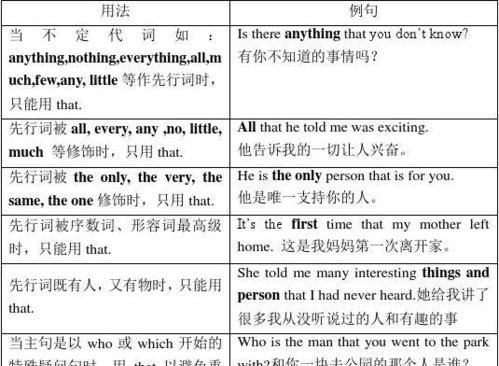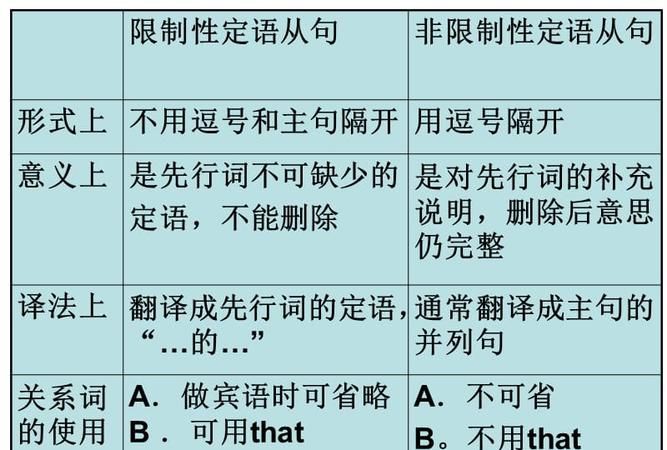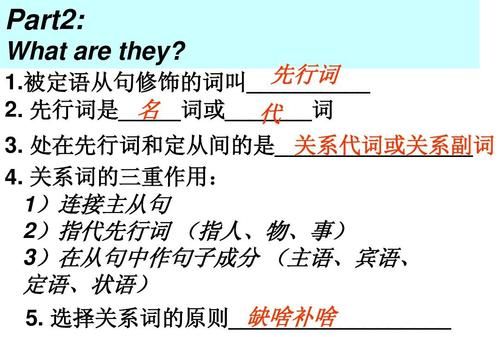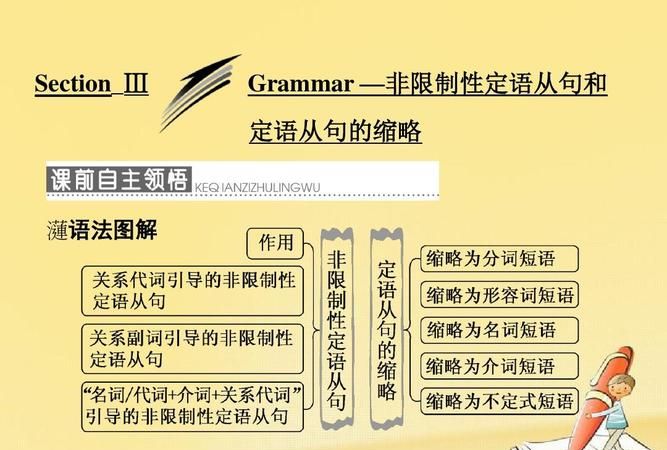本文目录
定语从句高考题语法填空版
一.几个基本概念
1.定语从句的定义:用作定语的从句叫定语从句。
2.先行词:被定语从句所修饰的名词或代词。
3.定语从句的位置:紧跟先行词(名词或代词)之后。
4.引导词:引导定语从句的词(包括关系代词和关系副词)。
﹙1﹚关系代词:that/who/whom/which/as
﹙2﹚关系副词:when/where/why
5.引导词的位置:位于定语从句之前(先行词之后)。【as除外】
6.引导词的功能(作用):
﹙1﹚连接先行词和定语从句。
﹙2﹚在定语从句中充当一定的成分(关系代词充当主语或宾语,关系副词充当状语)。
7.定语从句的类型:
﹙1﹚限定性定语从句(主句和定语从句之间无逗号)。
① 直接由引导词引导定语从句
The man who you’re talking to is my friend.
② 由介词+关系代词(whom/which)引导
The man to whom you’re talking is my friend.
I need a pen with which I can write a letter.
=I need a piece of paper on which I can write a letter.
介词的选用可根据从句中的相关词组确定,该介词通常可以放在关系代词之前,也可放在从句之尾。例如:
The man (who/whom/that) I talked about at the meeting is from Beijing University.
=The man about whom I talked at the meeting is from Beijing University.
The palace (which/that) I often pay a visit to was built in the 17th century.
=The palace to which I often pay a visit was built in the 17th century.
﹙2﹚非限定性定语从句(主句和定语从句之间用逗号隔开)。
① 直接由引导词引导定语从句。
② 由介词+关系代词(whom/which)引导。
I live in a house far away from the city, in front of which is a big tree.
There is an apple tree standing at the gate, on which are many apples.
This is the man to whom I gave the book.
③ 由“代词/名词+of+whom/which”或“of which/ whom +名词/代词”(先行词指
人用whom,指物用which)引导。One, some, any, none, all, both, several, many, most, neither, either等词、数词、分数或百分比与of whom或of which连用。
He has five children, two of whom are abroad.
(比较:He has five children, and two of them are abroad.)
We have three books, none of which is/are interesting.
(比较:We have three books, but none of them is/are interesting.)
除why和that不能引导非限定性定语从句外,其余引导词都可以,用法同限定性定语从句一样。但要注意以下区别。
1.在形式上非限定性定语从句与主句有逗号隔开。
2.非限定性定语从句的作用:它只是补充说明先行词的情况,翻译时可译成两个句子。
The engineer, whose leg was badly hurt, was quickly sent to hospital.
(那位工程师被很快送往医院,其腿部受了重伤)
The engineer whose leg was badly hurt was quickly sent to hospital.
(那位腿部受了重伤的工程师被很快送往医院)
3.在非限定性定语从句中,任何引导词都不能省略(包括引导词在此定语从句中充当宾语在内)。指人做主语时只能用who, 做宾语时用whom;
指物做主语,宾语都用which; 关系副词用when或where,也不能省略。
The man, ______ is sitting on the chair, is my father.
The woman, _______ I met yesterday, is my English teacher.
The city, _______ is far away, is very beautiful.
He went to America, ______ his parents live.
He joined the Army yesterday, ______ I left, too.
4.whose引导非限定性定语从句:
The house, whose window faces south, is mine.
=The house, the window of which faces south, is mine.
=The house, of which the window faces south, is mine.
二。定语从句中关系代词和关系副词的基本用法。
1.who/that指人是主格在定语从句中代替先行词,又作定语从句的主语,不能省略。
Do you know the gentleman who/that is sitting there?
2.whom/who/that指人是宾格,在定语从句中代替先行词,又作定语从句的宾语(动宾或介宾)。
① 当作动宾(动词后接宾语)时,关系代词可省略。
Do you know the gentleman (whom/who/that) we met just now?
② 当作介宾(介词后接宾语)时:
介词不提前时,关系代词可省略;
介词提前时,关系代词不可省,即介词+whom(指人时介词后的关系代词只能用whom)。
The man (whom/who/that) I spoke with is my teacher.
The man with whom I spoke is my teacher.
※注:固定的动词短语(动词+介词)如look for, take care of等不能把动词与介词拆开,既介词不能提至引导词前。
She is the right girl (who/whom/that) we are looking for.
3.whose: 指人或物,是所有格“…的”形式。Whose+n.一起在定语从句中充当主语、宾语(动宾或介宾)即先行词的什么东西怎样了,whose不能省略。Whose+n. = the +n. + of which/whom= of which/ whom+ the =n.
I didn’t find the desk whose leg was broken. (主语)
He is the student whose pencil I broke yesterday. (动宾)
The boss in whose company I work is very kind. (介宾)
4.which/that 指物,指代先行词且在定语从句中作主语或宾语(动宾或介宾)。
① 当作动宾时,关系代词可省略。
② 当作介宾时:
介词不提前时,关系代词可省略;
介词提前时,关系代词不可省,即介词+which(指物时介词后的关系代词只能用which)。
The house which/that was destroyed in the earthquake is weak.
The pen (which/that) you found yesterday is mine.
The games (that/which) the young men competed in were difficult.
The games in which the young men competed were difficult.
※注:介词+关系代词即介词+whom/which(先行词指人用whom,指物用which)。
※5.as指人或物,在定语从句中可作主语,宾语,表语或状语,不能省略。主要用于 “the same …as…;such …as…;so …as…;as … as…;as follows”固定结构中,形式固定此时的引导限定性定语从句。要用as代替who(m), which, 或that引导定语从句:
Such people as knew Hill thought he was honest.
Such people as Hill knew thought he was honest.
My hometown is no longer the same as it was.
Here is so big a stone as no one can lift.
The child knows as much as grow-ups (know).
I’d like to have the same books as are used in your school.
He is not such a person as I expected.
He will marry as pretty a girl as he can find.
※注:which和as可引导非限定性定语从句:可以指代主句中的一部分或整个句子的内容,which和as都可以指代主句中的一部分或整个句子的内容,有时可以互换。因此,当as/which指代前面的整个句子,或前句中的部分内容作定语从句的主语时,谓语用单数。
Our team lost the game, as/which was reported in the newspaper.
She was terrified, as/which I could see from her eyes.
He married her, as/which was natural.
区别:
①as引导的非限制性定语从句可以放在主句前面、插在主句中间或放在主句末尾;而which引导的非限制性定语从句只能放在主句后面。
He married her, as/which was natural.
=As was natural, he married her.
Mark Twin is a great writer, which/as is known to all.
=As is known to all, Mark Twin is a great writer.
②as引导的从句有“正如”、“正像”之意,而which则无此意。常用句型有:
as we all know, as is known to all, as everybody can see, as is expected, As is known/ said/ reported/ told/ we all know等。如:
As we all know, paper was first made in China.
To shut your eyes to facts, as many of you do, is foolish.
③主句和从句有因果关系时,用which.
Our class has won the football match, which made us very happy.
Bamboos are hollow, which makes them very light.
④从句含否定意义时常用which.
She didn’t pass the exam, which we couldn’t expect.
She didn’t pass the exam, as we expected.
6.when关系副词:指时间。在定语从句中作时间状语,不能省略。此时的when还可用介词+which替换(此时先行词一定是表时间的名词)。
I still remember the time when I joined the League.
=I still remember the time on which I joined the League.
=I still remember the time (which/that) I joined the League on.
7.where关系副词:指地点。在定语从句中作地点状语,不能省略。此时的when还可用介词+which替换(此时先行词一定是表地点的名词)。
I still remember the school where I joined the League.
=I still remember the school in which I joined the League.
=I still remember the school (which/that) I joined the League in.
※注:对关系副词when, where的认识。
①. 先行词是时间的名词,并非都用关系副词when引导定语从句。
I’ll never forget the time (which/that) I spent in Beijing.
②. 先行词是地点的名词,并非都用关系副词where引导定语从句。
This is the factory (which/that) he visited yesterday.
③. 当句型为It/This/That is(was) the first(second…last) time引起的句子时用that连接其后的句子。此时的time是次数,不是时间。
It/This is the first time that we travel.
It/This is the last time that I shall give you a lesson.
8. why指原因,在定语从句中作原因状语,先行词通常为reason,不能省略。且why引导的定语从句只能是限定性定语从句。Why= for which
I don’t know the reason why he was late yesterday.
The reason why(for which) he was late is that he missed the bus.
※注:当先行词为reason时,关系副词并非都用why.
This is the reason (that/ which) he gave/ explained to us.
【判断用关系代词还是关系副词】
从句缺少的是主语、宾语还是状语是确定用关系代词还是关系副词的关键。试比较:
I will never forget the day (which/that) I spent in Hongkong.
( spent是及物动词,后缺宾语,因此用关系代词或省略 )
I will never forget the day when/on which Hongkong returned to its motherland.
( 从句主谓宾结构完整,缺状语,因此用关系副词或介词加关系代词 )
The reason (that/which)he gave for not coming to school yesterday isn’t believable.
( gave是及物动词,后缺宾语,因此用关系代词或省略 )
The reason why he didn’t come to school yesterday isn’t believable.
( 从句主谓宾结构完整,缺状语,因此用关系副词或介词加关系代词 )
三。 值得注意的几个问题:
第一。 当先行词是物时,关系代词(that/which)只用that的情况。
1.当先行词被序数词或形容词的最高级修饰时。
This is the best film that has been shown this year.
This is the first book (that) I borrow from the library.
※He is the first student that/who came to school today.
2.当先行词为两个或两个以上分别指人和物的名词时。
He talked about the teachers and the school (that) he had visited.
3.当先行词本身是all的,用that.(all that=what)
All that (what) I want to say to you is “Thank you”.
=All (what) I want to say to you is “Thank you”.
Go over all that (what) we learned.
=Go over all (what) we learned.(that在定语从句中充当宾语可以省略)
4.先行词为something, anything, nothing, everything, thing时,用that.
I’ll tell you anything (that) I know.
5.当先行词前有all, much, little, many, (a) few, every, some, any, no, only, the very, one of, the only, the last, the next等修饰语时。
This is one of the books (that) I’m very interesting in.
※ This is one of the books in which I’m very interesting.
This is the only book (that) I read.
He is the only one of the boys that likes playing the piano.
All the glasses that were on the table fell off onto the floor.
6.(人,物),当先行词在以who或which开头的特殊疑问句中时,用that引导以避免混淆。
Who is the man that is talking with the lady?
Which of you that know the answer can come to the front?
7.当先行词是在定语从句中作表语时,用that.
He likes the girl that she used to be.
第二。 当先行词是物时,关系代词(that/which)只用which的情况。
1.作介宾且介词置于引导词之前时。
The room in which he lives is very large.
2.引导非限定性定语从句时(主,宾都用which,都不能省略).
Football, which is a very interesting game, is played all over the world.
The house, which I visited yesterday, is very large.
3.which指整个句子的内容或部分内容,引导非限定性定语从句。
He always makes fun of me, which upsets me.
第三。其他特殊情况。
1.先行词是these, those指人时,关系代词只用who.
Those who are playing over there are my students.
2.先行词是人称代词(he, she…)时,关系代词只用who.
He who doesn’t reach the Great Wall is not a true man.
3.不定代词someone, anyone, everyone, no one, somebody, anybody, everybody作先行词时,关系代词用who.
Anybody who breaks the rules would be punished.
4.①先行词是the only one of +可数名词复数,在定语从句中作主语时,定语从句中的谓语用单数形式(因为此时的先行词是the only one,而不是of 后的可数名词复数).
He is the only one of the boys that likes playing the piano.
This is the only one of the books that is borrowed.
②先行词是one of +可数名词复数,在定语从句中作主语时,定语从句中的谓语用复数形式(因为此时的先行词是of 后的可数名词复数,而不是one).
This is one of the students who are late.
5.当主句缺先行词时,用the one 代替,但须注意:the one只能代替可数名词单数。如为不可数名词时,指什么用什么。
Is this school the one I visited yesterday?
Is pop music the music he likes best?
6. 当先行词是the way,在定语从句中充当方式状语时(the way表“以…方式/方法”),引导词通常用that或省略,也可用in which.
I don’t like the way (that) you speak.
=I don’t like the way in which you speak.
=I don’t like the way (which/that) you speak in.
【“介词+关系代词”十种情况】
在定语从句中,介词+关系代词结构是一种较为复杂的问题。现就几种常见的介词+关系代词的结构浅析如下:
1.介词+which在定语从句中分别作时间、地点和原因状语,代替相应的关系副词when, where和why.如:I still remember the day on which (when) I first came to school.我仍然记得初来学校的那一天。
The factory in which (=where) I work is a large one.我工作的工厂是一个大工厂。
This is the reason for which (=why) he was late.这就是他为什么迟到的原因。
2.介词+which(指物)/ whom(指人)在定语从句中作地点状语,表示存在关系,定语从句主谓一般要倒置。
They arrived at a farmhouse, in front of which sat a small boy.他来到一处农舍,前边坐着一个小男孩。
I saw a man, on the head of whom stood a bird.我看见一个人,他的头上站着一只鸟。
3.介词+ which(指物)/ whom(指人)在定语从句中作目的、方式或地点状语。这种结构中的介词一般受动词或介词后的名词所制约。如:
Could you tell me for whom you’ve bought this coat?你能告诉我这件衣服是给谁买的吗?
The man, from whom I learned the news, is an engineer.这人是一位工程师,我是从他那里得到这消息的。
4.介词+which/whom,用于被动结构的定语从句中,作状语,说明动作的出发者。如:
The wolf by which the sheep was killed was shot.伤害羊的.那只狼被打了。
The man by whom the wolf was shot was a good hunter.打死狼的那人是个好猎手。
5.不定代词+of+which/whom,在定语从句中作主语,说明整体中的部分,常用的不定代词有:both, all, any, some, each, none, most等。如:
There are a lot of books here, none of which belongs to me.这儿有许多书,可一本也不属于我。
Yesterday Mary bought a few clothes, all of which were expensive.昨天玛丽买了一些衣服,他们都很贵。
6.数词+of+which/whom,在定语从句中作主语,说明整体与部分的关系。数词可以是基数词、序数词、分数或百分数。如:
In our class there are fifty-four students, twenty-five of whom are girls.我们班有54名学生,25人是女生。
Two watches were stolen, one of which was mine.两只手表被偷了,其中一只是我的。
7.名词+of+which代替whose+名词,在定语从句中作定语。如:
I saw some trees, the leaves of which (=whose leaves) were black with disease.我看见一些树,他们的叶子因害病而发黑。
I live in a house, the windows of which are all broken.我住在一所房子里,其窗都破了。
8.介词+ which(指物)/ whose(指人)修饰后边的名词。如:
It rained all night and all day, during which time the ship was broken into pieces.雨下了一天一夜,就在这期间轮船撞碎了。
The driver was the man from whose room she had stolen the maps.司机就是那个人,她从他的房间偷走地图。
9.形容词最高级+of+which/whom结构,在定语从句中,作定语,表部分关系。如:
China has thousands of islands, the largest of which is Taiwan.中国有成千上万个岛屿,其中最大的是台湾岛。
In our class there are twenty girls, the cleverest of whom is Li Hua.我们班有20名女生,最聪明的是李华。
10.介词+which+不定式。此种用法多见于正式文体中,相当于一个定语从句。如:
At last he had something about which to write home.他终于有了给家里写信的内容了。
He had no key with which to open the door.他没有开门的钥匙。
He has a small room in which to live.
【运用定语从句时应注意的几个问题】
1. 关系代词在定语从句中作主语时,定语从句的谓语动词应和先行词的人称和数保持一致。
This is one of the books which were written by Mark Twain.这是马克吐温所写的书中的一本。(先行词是books,因此动词应用were.)
2. 关系代词或关系副词在从句中充当一个句子成分,因此要注意避免从句中句子成分的重复出现。
This is the most beautiful place that I have visited it.
This is the most beautiful place that I have visited. 这是我参观过的最美的地方。(去掉it,因that代替先行词the most beautiful place在定语从句中作visit的宾语,再加it就多余了。)
The school where I worked there is a big one.
The school where I worked is a big one.我所工作过的学校是一所大学校。(去掉there,因where既引导定语从句,又在从句中代替in the school作状语。)
3. 关系代词在定语从句中作主语时不可省略。
The books were on the table were given to you.
The books that were on the table were given to you.桌上的那些书是给你的。(关系代词that作主语不能省)
4. “one of the +复数名词”后的定语从句中谓语动词的单复数情况。
“one of the +复数名词”时,复数名词是先行词,所以谓语动词常用复数形式。如果“one of the +复数名词”前面有the very /only等修饰语,则谓语动词用单数形式,因为先行词是,而不是复数名词。如:
He is the only one of the students who speaks Japanese in our class.他是我们班唯一说日语的学生。(the only one是先行词)
He is one of the students who speaks Japanese in our class.他是我们班里说日语的学生之一。(students是先行词)
5. 定语从句中who和whom的选用。
关系代词who/whom引导定语从句时,作主语用主格who,作宾语用宾格whom.在其引导的定语从句带有插入语,而又不用逗号分开时,要用who.
Mary is a girl who I think is clever.
在定语从句who I think is clever中, I think是插入语,去掉后Mary is a girl who is clever是一个完整的句子,who是定语从句的主语,不能用whom替换。但下面的句子,情况就不同了:
Mary is a girl whom I think to be clever.在定语从句whom I think to be clever中,如把I think看作插入语而去掉,则剩下的部分Mary is a girl whom to be clever很明显不是一个完整的句子结构,所以I think不能被看作是插入语,而是定语从句在的主谓结构,whom作think的宾语,to be clever是whom的宾补。
6. 定语从句中关系代词或关系副词的选择取决于它们在从句中所充当的句子成分。如作主语和宾语用关系代词;作状语,用关系副词。
I’ll never forget the day when I went abroad myself.(when在从句中代替时间状语on the day,此句可分解为I’ll never forget the day. I went abroad myself on the day.)
I’ll never forget the days that we spent together.(that代替the days,在从句中作spent的宾语,该句可分解为I’ll never forget the days. We spent the days together.)

定语从句 从句可以是完整句子么
这不是一个完整的句子。后面的从句原来应该是,and the mini society's members will merge into the larger real society.定语从句,又叫形容词从句,关系从句,前后两个句子之间必须有交集,由此建立联系,才可以用关系从句的方式把两个句子连接起来,你如果把members当作主语那句子的意思说不通,是哪里的成员呢?所以主语应该是the mini society's members
把这个句子换成两个句子就是,
A school stands for a mini society
Those members will finally merge into the larger real society.关系从句的特色在于关系词不是外加,而是由内含的重复元素改写而来,这里回答的重点来了,也就是定语从句后不是一个完整的句子
重要!!!!
另外再定语从句和名词从句都不是完整的句子,可以是完整的句子的从句只有状语从句也叫副词从句,因为定语从句和名词从句都可以在主句中担任重要的成分,比如主语,而一个句子缺失主语就没有意义。而状语从句只是起修饰作用,可有可无,

定语从句把两句话合成一句
定语从句,首先,去掉定语从句,原句依然完整.1.this is the hotel.语法上是完整的.
而宾语从句顾名思意就是作主句的宾语,所以去掉从句的话,主句就缺少宾语.eg.He laughed at what i said.这里的what I said就是宾语从句,去掉之后,主句就剩He laughed at,显然不完整.
这是最简单的分辨方法.其次就是定语从句一定有先行词的.

怎么判断定语从句中的从句是否完整
要先确定句子的主干,即主、谓、宾。谓语的性一定是和主语的性、数对应的,宾语一定是谓语的指向。再看其他成分的情况,修饰名词的一定定语(当然英语中主语会有补语,但一般再句尾)修饰动词的一定是状语或补语了!
找定语从句关键是要找到中心语和从句的引导词,一般是:who,when,what,why,how,as,since,that等;此外定语从句很多时候在它修饰的中心语的后面,或者前后都用逗号把它和整个句子隔开!

以上就是关于定语从句的从句完整 ,定语从句高考题语法填空版的全部内容,以及定语从句的从句完整 的相关内容,希望能够帮到您。

